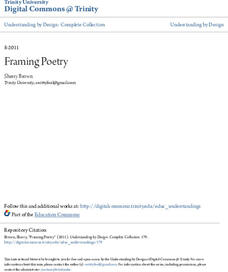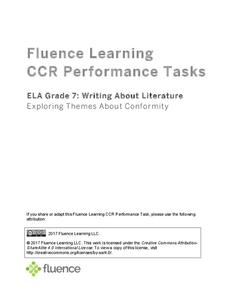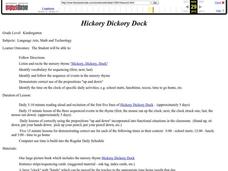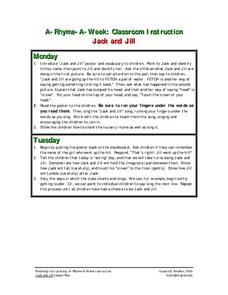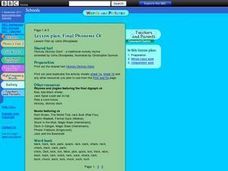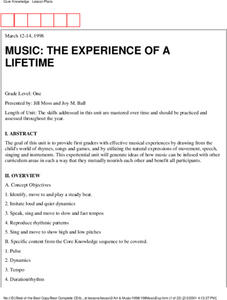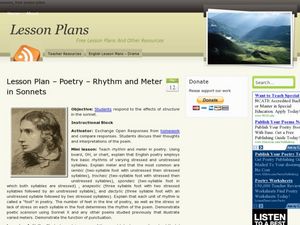Ereading Worksheets
Figurative Language for Edgar Allen Poe
Are your classes weary of dreary worksheets? Are the learners nearly napping? Thrill them, fill them with delight with an interactive worksheet that asks them to identify the figurative language Edgar Allen Poe uses to add horror and...
EBSCO Industries
Music and Poetry
Song lyrics, like poems, are meant to be heard. After examining the literary devices in several poems, scholars examine the lyrics of popular songs and identify the sound devices and the figurative language writers use to create the...
Curated OER
A Poem to Share
This festive winter poem incorporates rhyming using the oa sound. Readers examine the words to find examples that use that sound. This is good phonics exposure to words that have the same sound but are spelled differently....
Prestwick House
Discovering Genre: Poetry
Work on literal and figurative meanings with a instructional activity focused on Robert Frost's "After Apple-Picking" and "The Road Not Taken." Readers identify the literary devices used by the poet to set the poems' themes,...
Trinity University
Framing Poetry
The big idea in this poetry unit plan is that structure and content work together to create meaning. Class members learn how to identify and mark the metrical patterns and line lengths used in poems. They study the structure of various...
Curated OER
Ballad
Young balladeers analyze examples of ballads and generate a list of common traits (story, quatrains, rhyme schemes, refrains, etc.), then identify these traits in Robert W. Service's "The Cremation of Sam McGee" and a ballad written by...
Curated OER
Tone
Identifying the tone in a piece of writing can be tricky. Readers don't have the advantage of studying the images and colors used in a painting or the instruments and sounds of a song. The second activity in this poetry unit teaches...
Fluence Learning
Writing About Literature: Exploring Themes About Conformity
Feeling the pressure to confirm is something any adolescent can relate to. Explore an essential theme with a response to literature assessment that prompts learners to identify main ideas with evidence and supporting details.
Curated OER
Identify Poetic Devices
In this poetic devices worksheet, students identify devices being used as alliteration, rhyme, onomatopoeia, rhyme, idiom, simile, metaphor, hyperbole or personification and explain their choice.
Curated OER
Characters
Bring a lesson on nursery rhymes to your kindergarten class room. Kids listen to Three Blind Mice and identify the characters. They then decide which parts of the story make it a nursery rhyme. For extra practice, use the same...
Can Teach
Groundhog Day Songs and Poems
This Groundhog Day add a bit of rhythm and rhyme with 23 songs and poems that put a spotlight on the holiday's shining star, the groundhog.
Curated OER
Hickory Dickory Dock
Students use the Hickory Dickory Dock nursery rhyme to learn about rhyme, telling time, and preposition use. In this nursery rhyme lesson, students read the nursery rhyme daily and complete a Mother Goose quiz. Students sequence the...
Curated OER
Jack And Jill
Students engage in a instructional activity that is concerned with the reading of "Jack and Jill" with the help of a poster to set the context for class activities like discussion. They read the story and fill in the blanks for the words...
Curated OER
A Little Alliteration
Second graders study rhythm, rhyme, and alliteration in poetry by completing various activities. In this language arts lesson, 2nd graders practice recognizing alliteration and then create their own poem using alliteration.
Curated OER
Kinder Poems & Songs
Students complete a year-long unit for poetry and songs. In this poetry and songs lesson, students complete nine lessons for animal songs and animal poetry to improve their understanding of rhyme, rhythm, and poetry.
Curated OER
The Gingerbread Story
Learners explore storytelling by reading a classic book. In this story structure lesson plan, students read the story The Gingerbread Man and identify the characters, settings and plot. Learners answer reading comprehension questions...
Curated OER
Final Phoneme CK
Students discuss types of rhyme and identify the words in a poem that end in ck. They write their own stories about a mouse and his amazing adventure.
Curated OER
I am Special and You are Special Too #9
Eighth graders will explore the rhythm and rhyme of poems to understand the basic elements of poetry. In this poetry and literary lesson, 8th graders relate their love for rap music to poetry. Students will discuss...
Curated OER
Music: The Experience of a Lifetime
Students use rhymes, songs and games to help them study music. They discover how music can be used with movement, speech and singing.
Curated OER
My Spelling Words: Spelling List #17
In this spelling worksheet, students practice reading and writing 12 spelling words. Afterward, they read a Dr. Seuss story and identify words in the story that rhyme with their spelling words. Spelling words are one syllable, containing...
Curated OER
Rhyming Words
In this rhyming words activity, students examine the 5 listed words and identify 3 words that rhyme with each of the words listed.
Curated OER
Phonological Awareness and Rhyming
Students listen to a story and chime whenever they hear rhyming word pairs. Students generate other rhyming words that rhyme with each pair from the story. Students draw and/or paint illustrations to go along with a rhyming song given....
Curated OER
Homophones and Rhyming Words
First graders explore homophones. In this spelling pattern instructional activity, 1st graders are led through a discussion on homophones and words that rhyme with homophones. The teacher leads the class in sorting these rhyming words...
Curated OER
Poetry--Rhythm and Meter in Sonnets
Students identify rhyme scheme and meter in a poem and respond to the message of the poem. In this sonnet rhythm and meter lesson, students take notes on a lecture about rhythm and meter in sonnets and work in small groups to read...




